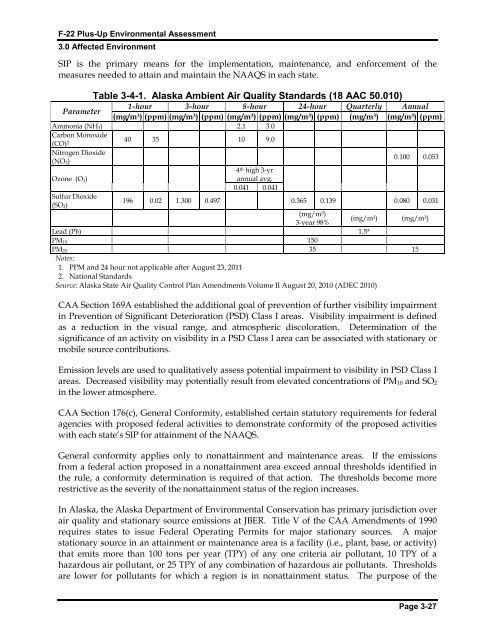F-22 Plus-Up Environmental Assessment - Joint Base Elmendorf ...
F-22 Plus-Up Environmental Assessment - Joint Base Elmendorf ...
F-22 Plus-Up Environmental Assessment - Joint Base Elmendorf ...
Create successful ePaper yourself
Turn your PDF publications into a flip-book with our unique Google optimized e-Paper software.
F-<strong>22</strong> <strong>Plus</strong>-<strong>Up</strong> <strong>Environmental</strong> <strong>Assessment</strong><br />
3.0 Affected Environment<br />
SIP is the primary means for the implementation, maintenance, and enforcement of the<br />
measures needed to attain and maintain the NAAQS in each state.<br />
Table 3-4-1. Alaska Ambient Air Quality Standards (18 AAC 50.010)<br />
Parameter<br />
1-hour 3-hour 8-hour 24-hour Quarterly Annual<br />
(mg/m 3 ) (ppm) (mg/m 3 ) (ppm) (mg/m 3 ) (ppm) (mg/m 3 ) (ppm) (mg/m 3 ) (mg/m 3 ) (ppm)<br />
Ammonia (NH 3) 2.1 3.0<br />
Carbon Monoxide<br />
(CO) 2<br />
40 35 10 9.0<br />
Nitrogen Dioxide<br />
(NO 2)<br />
0.100 0.053<br />
4 th high 3-yr<br />
Ozone (O 3)<br />
annual avg.<br />
0.041 0.041<br />
Sulfur Dioxide<br />
(SO 2)<br />
196 0.02 1.300 0.497 0.365 0.139 0.080 0.031<br />
(mg/m 3 )<br />
3-year 98%<br />
(mg/m 3 ) (mg/m 3 )<br />
Lead (Pb) 1.5*<br />
PM 10 150<br />
PM 25 35 15<br />
Notes:<br />
1. PPM and 24 hour not applicable after August 23, 2011<br />
2. National Standards<br />
Source: Alaska State Air Quality Control Plan Amendments Volume II August 20, 2010 (ADEC 2010)<br />
CAA Section 169A established the additional goal of prevention of further visibility impairment<br />
in Prevention of Significant Deterioration (PSD) Class I areas. Visibility impairment is defined<br />
as a reduction in the visual range, and atmospheric discoloration. Determination of the<br />
significance of an activity on visibility in a PSD Class I area can be associated with stationary or<br />
mobile source contributions.<br />
Emission levels are used to qualitatively assess potential impairment to visibility in PSD Class I<br />
areas. Decreased visibility may potentially result from elevated concentrations of PM 10 and SO 2<br />
in the lower atmosphere.<br />
CAA Section 176(c), General Conformity, established certain statutory requirements for federal<br />
agencies with proposed federal activities to demonstrate conformity of the proposed activities<br />
with each state’s SIP for attainment of the NAAQS.<br />
General conformity applies only to nonattainment and maintenance areas. If the emissions<br />
from a federal action proposed in a nonattainment area exceed annual thresholds identified in<br />
the rule, a conformity determination is required of that action. The thresholds become more<br />
restrictive as the severity of the nonattainment status of the region increases.<br />
In Alaska, the Alaska Department of <strong>Environmental</strong> Conservation has primary jurisdiction over<br />
air quality and stationary source emissions at JBER. Title V of the CAA Amendments of 1990<br />
requires states to issue Federal Operating Permits for major stationary sources. A major<br />
stationary source in an attainment or maintenance area is a facility (i.e., plant, base, or activity)<br />
that emits more than 100 tons per year (TPY) of any one criteria air pollutant, 10 TPY of a<br />
hazardous air pollutant, or 25 TPY of any combination of hazardous air pollutants. Thresholds<br />
are lower for pollutants for which a region is in nonattainment status. The purpose of the<br />
Page 3-27
















